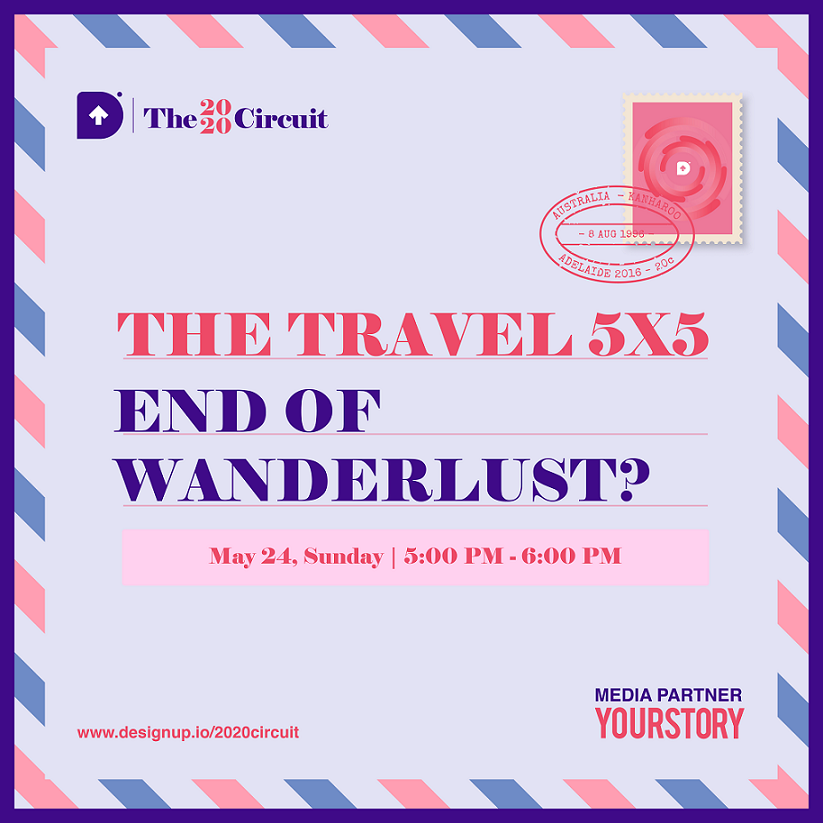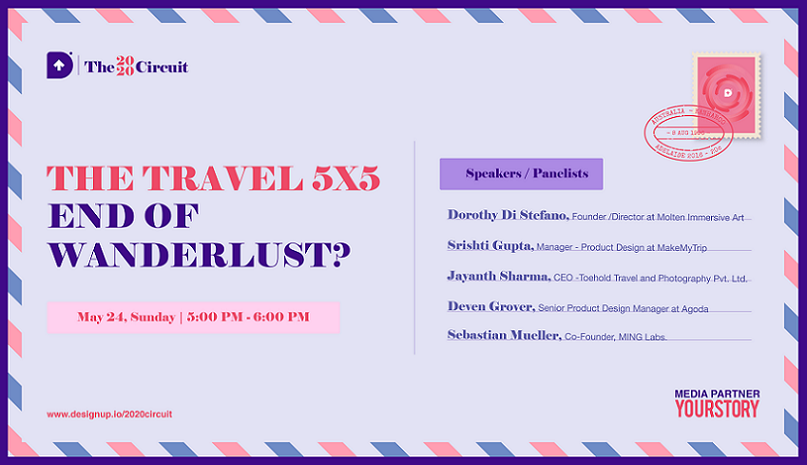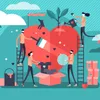The team behind the DesignUp conferences is hosting a panel this coming Sunday, May 24, 5-6 pm, titled ‘The Travel 5×5: End of Wanderlust?’ YourStory is the media partner for the event (click here for free registration).
See YourStory’s coverage of the annual DesignUp conference editions from 2019, 2018 and 2017, as well as our d-Zen (‘Design Zen’) section for more design resources. Also, check out our coverage of DesignUp’s earlier online panels, The (not so) Secret Life of Designers, May the Fourth be with you and The pandemic’s impact on design as a business.
Five speakers from five cities will deliver fast-paced lightning presentations on virtual travel, changing preferences, and choice of destination. The panellists are from Bengaluru, Delhi, Bangkok, Sydney, and Singapore.
In this first preview article, the panellists set the stage on how the design community has responded to the pandemic challenge, productivity tips for work from home, and implications for the travel sector. See also the DesignUp report, Deconstruct: Understanding the State of Design-In-Tech.
The speaker lineup includes Dorothy Di Stefano, Founder-Director, Molten Immersive Art;
Srishti Gupta, Manager, Product Design, MakeMyTrip; Jayanth Sharma, CEO, Toehold Travel and Photography; Deven Grover, Senior Product Design Manager, Agoda; and Sebastian Mueller, Co-founder, MING Labs.
Design responses to the pandemic
Each of the speakers shared outstanding examples of how the design and arts community has responded to the range of challenges thrown up by the coronavirus. Sebastian Müller points to the Scener browser extension that allows users to co-watch Netflix, IKEA’s collection of backgrounds to get inspired in times of video calls, and projections of national flags on Switzerland’s Matterhorn peak as signs of solidarity.
Srishti Gupta picks three fields in which people from various disciplines are applying design thinking to solve key problems in the post-COVID-19 world: contactless tech, ventilators, and telehealth.
“A lot of effort until now has gone into touch-based or fingerprint-based biometric devices. COVID-19 has forced us to shift gears and expand our understanding of contactless tech,” she observes, in a chat with YourStory. Though it has been around for some time, she sees exciting possibilities for Google’s project Soli.
The ventilator is a lifesaving medical equipment that is currently very expensive. There are teams of mechanical engineers and doctors coming together to redesign it and bring down its cost drastically. “A good example is from our very own Indian Railways,” Srishti observes.
They are designing a ventilator called JEEVAN that costs just up to Rs 15,000 to Rs 20,000 per unit. “A device like this could make the difference when it comes to treating COVID-19 related cases in developing nations like our own,” she emphasises.
“The emergence of telehealth in India is on the rise and it is not just concentrated in the metros,” Srishti adds. Examples include Biocalculus, a wearable ECG device invented by a Kerala based startup. Also Read[Techie Tuesday] This engineer went from healthcare and political psychology to mini ICUs for coronavirus patients
Also Read[Techie Tuesday] This engineer went from healthcare and political psychology to mini ICUs for coronavirus patients
As notable examples of good design responses in these times, Deven Grover lists recent developments at Airbnb, Miro, and Mucinex. “Airbnb has helped guests discover the world through online experiences. It has given hosts an opportunity to expand their content in a new platform even while the world stays in lockdown mode,” he explains.
“These online experiences have helped many guests get off YouTube, social channels and Netflix, and be able to experience new adventures virtually while social distancing in isolation,” Deven explains.
Miro, a free online collaborative platform for UX designers, has helped design teams across the world by using effective tools. He says it helps them conduct workshops, whiteboarding, and bring teams together anytime, anywhere to collaborate.
The company behind Mucinex, an expectorant drug, started a campaign called Spread Facts, Not Fear. “It was launched to help stop misinformation on coronavirus solutions and educate people properly. This helped lower anxiety and drive people to reliable sources to navigate through this crisis,” Deven says. “It was great to see a company take the effort to educate their users via a campaign that wouldn’t necessarily have RoI,” he adds.
From the public art and entertainment world, Dorothy di Stefano cited three examples. Finnish light artist Kari Kola created one of the largest illuminated artworks, The Savage Beauty using the beauty of the Connemara mountains as his backdrop. The Make it Blue Collective (UK), an initiative organised by the events and entertainment industry to salute the brave NHS staff, lit up buildings around cities in different hues of blue.
“This initiative has also spread to the US,” Dorothy explains. And at the end of their 15-minute drone performance, art collective Studio DRIFT created a red, pulsating, three-dimensional heart shape in the sky above Rotterdam in honour of healthcare workers.
Wildlife photographer Jayanth Sharma points to some of Adira’s face masks as a good example of design in the current context. “It not only addresses the current market need, but also blends it with wildlife and nature lovers’ obsession with anything wild,” he explains.
As other examples, he cites Creator’s automated tools designed with food safety in mind, and the Diversey Hygienizer kit for safety.
 Knowledge and learning
Knowledge and learning
The speakers also shared the names of useful books on their reading lists these days. Dorothy’s picks include A New Earth (Eckhart Tolle), Our Senses (Rob DeSalle, Patricia Wynne), and The Biology of Belief (Bruce Lipton).
Deven’s reading list includes Winning (Jack Welch), Work Rules (Laszlo Bock), and Radical Candor (Kim Scott). Three books on Srishti’s reading list are Lifespan (David Sinclair), This Changes Everything: Capitalism vs. The Climate (Naomi Klein), and No interface is the best interface (Golden Krishna).
Sebastian recommends the following books: Upstream: The Quest to Solve Problems Before They Happen (Dan Heath), Narrative Economics: How Stories Go Viral and Drive Major Economic Events (Robert Shiller), and An Elegant Defense: The Extraordinary New Science of the Immune System: A Tale in Four Lives (Matt Richtel).
Jayanth has recently read The High Performance Entrepreneur by Subroto Bagchi. “I also bought a couple of digital marketing ebooks to learn a few things I need the most now,” he adds.
See also YourStory’s extensive book review section with titles covered in the past eight years. Over 250 books have been reviewed, on topics like creativity, entrepreneurship, innovation, design, and digital transformation.
Planning in an age of uncertainty
Given how fast medical responses and post-lockdown measures are changing, it is hard for organisations to plan and execute efficiently in these times of uncertainty. The panellists shared a range of hard-earned lessons in this regard.
“The first rule of effective and planning and execution is definitely having the right project management software. This is even more important during these times,” Dorothy emphasises. Being about to provide read access to suppliers is also very useful, she adds.
“Daily communication with the team and weekly communication with clients is very important to ensure that all is going to plan,” she says. “We all need to be understanding during this time. Things can change overnight so we need to be flexible to these changes,” Dorothy observes.
“We can only navigate by assumptions and probabilities – everything must be treated as a hypothesis. Organisations need to speed up their learning, they must propagate new insights quickly through the whole company,” Sebastian advises.
In an age of information overload and news continuously breaking round the clock from around the world, it is easy to get overwhelmed. “Don't get too drawn into the news, a lot of things will be temporary,” he observes.
Planning applies to daily activities and routines as well. “Many of us don’t have dedicated home offices and might even be sharing the space with others. It becomes important to work strategically according to our new work environments,” Srishti advises.
“For instance, If you find it easier to be less distracted at your work spot in the morning, make sure you use that time to do the individual contributor tasks at that time and plan your meetings accordingly,” she explains.
“WFH for so long can make the days blur together. I try to avoid that making a routine which allows me to do a variety of tasks,” Srishti adds. These include self-care (eg. meditation, a fitness regime), work, social engagement (interacting with people outside the house) or self-development (spending time doing something constructive and enjoyable).
“This helps break up the time into different sections on what can sometimes seem like Groundhog’s Day,” she jokes. Also ReadWhy philanthropic collaborations should thrive and lead the battle against COVID-19
Also ReadWhy philanthropic collaborations should thrive and lead the battle against COVID-19
“As a business owner, I am focusing on major cost-cutting. I am not hiring at the moment, looking at fixed costs and optimising it,” Jayanth explains. For example, he has exited his office in Pune for the time being and is operating only from Mumbai.
“I also would not launch optimistic or ambitious projects. I will move as much as possible towards remote working and online delivery of services like teaching and training,” he adds.
As planning and execution approaches, Deven emphasises the importance of effective communication to understand stakeholder needs that change as we progress through the crisis. “Ensure your team understands that as the virus navigates different stages, we will have to pivot our strategy many times to adjust to our users and their needs,” he emphasises.
“Throw out long term initiatives and focus on short term goals that make an impact and align with the business,” he adds. He advises creating a strategy during and after the crisis that is COVID-proof.
“This will help align the team and provide focus at each stage, and how best the team can drive impact. It will keep the team’s focus on value for user and business needs,” Deven says.
WFH approaches should also be periodically reviewed to see how effective they are, and what changes need to be made to ensure flexibility once commuting starts again. “Be understanding of employees’ anxiety and their unwillingness to come to the office till they feel comfortable that the virus is contained,” Deven emphasises.
“Be flexible and understanding of what will make your team at ease. Adapt your company structure and communication to follow,” he sums up.
Travel in the post-Covid world
“Travel has been one of the worst hit segments in the pandemic, so in some ways it is a really top-of-the-charts subject when it comes to recovery approaches,” explains Jay Dutta, SVP UX Design at MakeMyTrip, and Founder-Curator, DesignUp Festival.
“I work in travel, and like a whole lot of people I love travel and the process of planning travel. Interestingly, in our earlier DesignUp panel, one of the speakers – Fatema Raja from Gojek – also spoke about it from a traveller’s perspective,” Jay recalls, explaining the build-up to the next panel.
“Finding a diverse bunch of speakers for the discussion was critical. We are delighted to have folks from varied backgrounds, expertise, experiences, and countries,” he adds.
See also YourStory’s recent interview with MakeMyTrip Founder Deep Kalra on how people will travel in a post-COVID-19 world. The future will be marked by stricter hygiene protocols, destinations designed for safe distancing, and massive revival support by government.
Given how important the travel, tourism and hospitality sector is for the overall economy, its response and resilience will be instructive for other sectors as well.
(Edited by Saheli Sen Gupta)
How has the coronavirus outbreak disrupted your life? And how are you dealing with it? Write to us or send us a video with subject line 'Coronavirus Disruption' to editorial@yourstory.com
Read more: yourstory.com